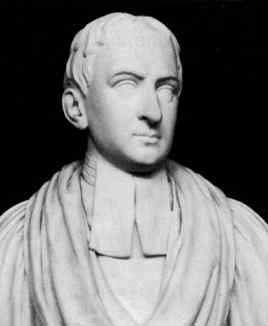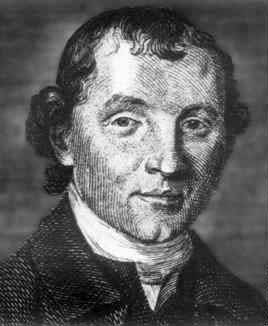<Back to Index>
- Mathematician Roger Cotes, 1682
- Mathematician and Inventor Thomas Simpson, 1710
PAGE SPONSOR

Roger Cotes FRS (10 July 1682 — 5 June 1716) was an English mathematician, known for working closely with Isaac Newton by proofreading the second edition of his famous book, the Principia, before publication. He also invented the quadrature formulas known as Newton – Cotes formulas and first introduced what is known today as Euler's formula. He was the first Plumian Professor at Cambridge University from 1707 until his death.
Cotes was born in Burbage, Leicestershire. His parents were Robert, the rector of Burbage, and his wife Grace née Farmer. Roger had an elder brother, Anthony (born 1681) and a younger sister, Susanna (born 1683). At first Roger attended Leicester School where his mathematical talent was recognized. His aunt Hannah had married Rev. John Smith, and Smith took on the role of tutor to encourage Roger's talent. The Smiths' son, Robert Smith, would become a close associate of Roger Cotes throughout his life. Cotes later studied at St Paul's School in London and entered Trinity College, Cambridge in 1699. He graduated BA in 1702 and MA in 1706.
Roger Cotes's contributions to modern computational methods lie heavily in the fields of astronomy and mathematics. Cotes began his educational career with a focus on astronomy. He became a fellow of Trinity College in 1707, and at age 26 he became the first Plumian Professor of Astronomy and Experimental Philosophy. On his appointment to professor, he opened a subscription list in an effort to provide an observatory for Trinity. Unfortunately, the observatory still was unfinished when Cotes died, and was demolished in 1797.
In correspondence with Isaac Newton, Cotes designed a heliostat telescope with a mirror revolving by clockwork. He recomputed the solar and planetary tables of Giovanni Domenico Cassini and John Flamsteed, and he intended to create tables of the moon's motion, based on Newtonian principles. Finally, in 1707 he formed a school of physical sciences at Trinity in partnership with William Whiston.
From 1709 to 1713, Cotes became heavily involved with the second edition of Newton's Principia, a book that explained Newton's theory of universal gravitation. The first edition of Principia had only a few copies printed and was in need of revision to include Newton's works and principles of lunar and planetary theory. Newton at first had a casual approach to the revision, since he had all but given up scientific work. However, through the vigorous passion displayed by Cotes, Newton's scientific hunger was once again reignited. The two spent nearly three and half years collaborating on the work, in which they fully deduce, from Newton's laws of motion, the theory of the moon, the equinoxes, and the orbits of comets. Only 750 copies of the second edition were printed. However, a pirate copy from Amsterdam met all other demand. As reward to Cotes, he was given a share of the profits and 12 copies of his own. Cotes's original contribution to the work was a preface which supported the scientific superiority of Newton's principles over the then popular vortex theory of gravity advocated by René Descartes. Cotes concluded that the Newton's law of gravitation was confirmed by observation of celestial phenomenon that were inconsistent with the vortex phenomena that Cartesian critics alleged.
Cotes's major original work was in mathematics, especially in the fields of integral calculus, logarithms, and numerical analysis. He published only one scientific paper in his lifetime, entitled Logometrica, in which he successfully constructs the logarithmic spiral. After his death, many of Cotes's mathematical papers were hastily edited by Robert Smith and published in a book, Harmonia mensurarum. Cotes's additional works were later published in Thomas Simpson's The Doctrine and Application of Fluxions. Although Cotes's style was somewhat obscure, his systematic approach to integration and mathematical theory was highly regarded by his peers. Cotes discovered an important theorem on the nth roots of unity, foresaw the method of least squares, and he discovered a method for integrating rational fractions with binomial denominators. He was also praised for his efforts in numerical methods, especially in interpolation methods and his table construction techniques. He was regarded as one of the few British mathematicians capable of following the powerful work of Sir Isaac Newton.
Cotes died from a violent fever in Cambridge in 1716 at the early age of 33. Isaac Newton remarked, "If he had lived we would have known something."

Thomas Simpson FRS (20 August 1710 – 14 May 1761) was a British mathematician, inventor and eponym of Simpson's rule to approximate definite integrals. The attribution, as often in mathematics, can be debated: this rule had been found 100 years earlier by Johannes Kepler, and in German is the so-called Keplersche Fassregel.
Simpson was born in Market Bosworth, Leicestershire. The son of a weaver, Simpson taught himself mathematics, then turned to astrology after seeing a solar eclipse. He also dabbled in divination and caused fits in a girl after 'raising a devil' from her. After this incident, he and his wife had to flee to Derby. They later moved to London.
From 1743, he taught mathematics at the Royal Military Academy, Woolwich.
Apparently, the method that became known as Simpson's rule was well known and used earlier by Bonaventura Cavalieri (a student of Galileo) in 1639, later rediscovered by James Gregory (who Simpson succeeded as Regius Professor of Mathematics at the University of St Andrews) and was only attributed to Simpson.
Simpson was a fellow of the Royal Society. In 1758, Simpson was elected a foreign member of the Royal Swedish Academy of Sciences.